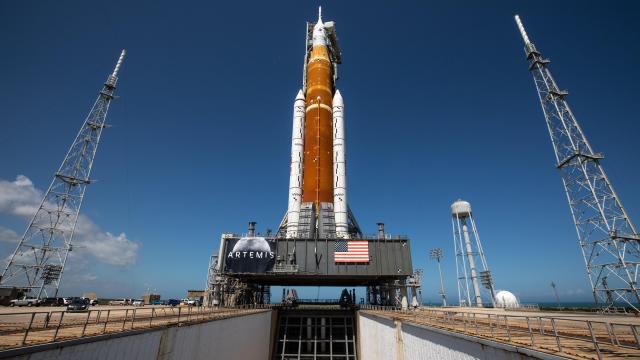On Thursday, the NASA Office of Inspector General issued a fiery report concerning a mobile launch tower in development for the agency’s Artemis Moon missions that’s now more than twice over budget and running years behind schedule.
NASA had awarded a $US383 ($532) million contract to private company Bechtel in June 2019 to design and build a second mobile launch tower (ML-2) for the Artemis program. The new audit, released yesterday, suggests the total cost could run as high as $US1.5 ($2) billion. That’s an astounding cost overrun and an upsetting setback for NASA’s Artemis program, which seeks to maintain a sustained human presence on and around the Moon.
The 117.96 m-tall (118-metre) tower is meant to support the fuelling and liftoff of a larger version of NASA’s Space Launch System, which is currently suffering from delays as the space agency prepares for the inaugural launch of the rocket, the Artemis 1 mission. Bechtel was supposed to deliver the launcher in March 2023, but the project has since suffered from several delays and cost hikes.
By May 2022, Bechtel had not yet completed the design work for ML-2, with the firm estimating that construction of the launcher wouldn’t begin until the first quarter of 2023. The auditor’s report now lists the cost of the mobile launcher at $US960.1 ($1,333) million and with a new expected delivery date of October 2025. That said, “[we] expect further cost increases as inevitable technical challenges arise when ML-2 construction begins,” the auditor’s report warned.
In the report, Bechtel took most of the blame, but NASA was also called out for mismanagement. “The ML-2’s substantial cost increases and schedule delays can be attributed primarily to Bechtel’s poor performance,” the report read. “Bechtel underestimated the ML-2 project’s scope and complexity, experienced ML-2 weight management challenges, and experienced staffing turnover and retention issues.” Betchel’s original estimate for the weight of the mobile launcher was around 5.4 million kilograms, but another 400,000 kg was tacked onto the launcher’s estimated weight in January.
The Inspector General’s report predicted things would get even worse. An independent review team found that the launcher project will require an additional $US447 ($621) million, bringing its total cost to $US1.5 ($2) billion, and that its delivery date would be no earlier than December 2027. That unsettling prediction would push back the launch of Artemis 4, which will transport four astronauts to the planned Lunar Gateway on board the upgraded version of the SLS rocket that requires ML-2. Artemis 4 is supposed to launch in 2026.
Unsurprisingly, Bechtel disagreed with the audit. “Unfortunately, the Inspector General’s report does not provide a complete picture of what led to the current situation, and we strongly disagree with the report’s overarching conclusions on the primary causes of the cost increases,” a Bechtel spokesperson told SpaceNews.
As the Inspector General’s report points out, NASA is currently looking to convert parts of the ML-2 contract to a fixed-price structure, but it’s “too early to tell what impact, if any, these efforts will have on improving the trajectory of the project,” the report read.
This report is obviously not good news, as NASA is already feeling the pressure to responsibly and accountably roll out the Artemis program. In March, the House Science Committee’s space subcommittee questioned NASA over schedule delays and cost overruns for Artemis, voicing concerns over the space agency’s plan to return humans to the Moon. NASA is also having trouble launching Artemis 1, the uncrewed mission meant to kick-start the return to the Moon. The jumbo SLS rocket is struggling to get through a complete wet dress rehearsal ahead of its launch, with three failed attempts already in the books, delaying the mission from June to no earlier than August.
